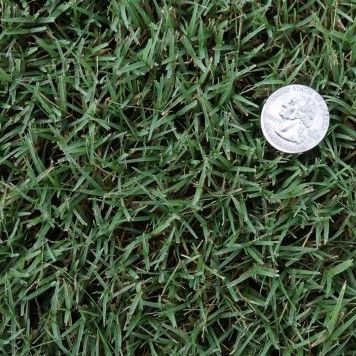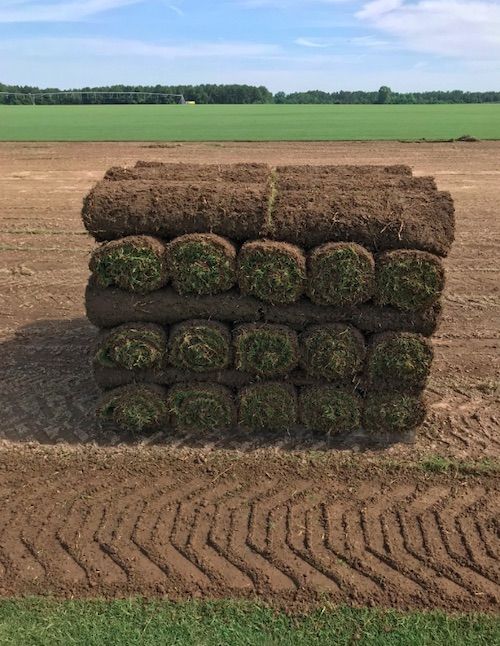
- Bermuda Tifway 419 is a hybrid Bermuda grass that was released by the University of Georgia in 1960. Due to its intense green color homeowners love this grass for their lawns, but it is also well suited for fairways, roughs and tees. It is able to maintain its green color longer than other selections of Bermuda grass. It has proven itself to be disease and insect resistant.
Bladed
to Thrive
- Tifway 419 ranks in the top 97% of all leading Bermuda grasses according to comparative testing.
- Blade Width: 1.7
- Full Sun for Best Results
- Rapid Growth
- Very Dense Fine Texture
- Very Drought Tolerant
- Excellent Wear Tolerance
- Very Good Spring Green-up
- Excellent Injury Recovery
- Very Good Weed Control
- Good Insect Tolerance
- Recommended Mowing Height: 1-2"
Maintenance Water your new lawn to keep it moist for a period of 2 weeks or until sod is rooted.
Water your new lawn to keep it moist for a period of 2 weeks or until sod is rooted.
MOWING: Mow as soon as your new lawn is rooted - at the recommended height(see table below).
Fertilize your new lawn once rooted.
Once your new lawn is rooted follow the chart below.
Mow when grass is this tall: 1.5" 3.5cm
Set cutting height of mower to: 1" 2.5cm
Mow with sharp mower blades.
Water to supplement rainfall shortages only. Avoid fixed timer irrigations settings. Bermuda best performs when it receives approximately 1 inch of water per week. If one or more inches of rainfall occur in a week,additional irrigation is not necessary. Do not water by over watering.
Season Fertilizer Weed Control
Early Spring Weed and Feed Pre-Emerge
Late Spring 20lbs 16-4-8 + Iron As needed
Early Summer 20lbs 16-4-8 + Iron As-needed
Late Summer 20lbs 16-4-8 + Iron As-needed
Fall 30lbs 5-10-15 + Iron Pre-emerge
| Bermuda Grass Comparison Testing | ||||||||||||||
| Grass Type | Overall Quality | Color | Spring Green Up Rating | Leaf Texture (NC) | Summer Density Rating (NC) | Fall Density Rating (NC) | Spring % Living (NC) | Summer % Living (NC) | Fall % Living (NC) | Dollar Spot Rating (NC) | September Color Rating | October Color Rating | November Color Rating | December Color Rating |
| Tifway | 60% | 67% | 63% | 77% | 73% | 77% | 94.30% | 98.30% | 99% | 47% | 60% | 60% | 53% | 30% |
| Tiftuf | 62% | 67% | 70% | 80% | 80% | 80% | 96.30% | 99% | 99% | 50% | 60% | 60% | 57% | 27% |
| Latitude | 59% | 60% | 56% | 73% | 80% | 80% | 95% | 97.70% | 99% | 47% | 60% | 60% | 53% | 17% |
| Celebration | 57% | 60% | 43% | 70% | 77% | 73% | 86.70% | 94.70% | 98.30% | 50% | 60% | 57% | 50% | 10% |
More Info:
The blades are a grey-green colour and are short, usually 2–15 cm (0.79–5.91 in) long with rough edges. The erect stems can grow 1–30 cm (0.39–11.81 in) tall. The stems are slightly flattened, often tinged purple in colour.
The seed heads are produced in a cluster of two to six spikes together at the top of the stem, each spike 2–5 cm (0.79–1.97 in) long.
It has a deep root system; in drought situations with penetrable soil, the root system can grow to over 2 metres (6.6 ft) deep, though most of the root mass is less than 60 centimetres (24 in) under the surface. The grass creeps along the ground and roots wherever a node touches the ground, forming a dense mat. C. dactylon reproduces through seeds, runners, and rhizomes. Growth begins at temperatures above 15 °C (59 °F) with optimum growth between 24 and 37 °C (75 and 99 °F); in winter, the grass becomes dormant and turns brown. Growth is promoted by full sun and retarded by full shade, e.g., close to tree trunks.
- Hot weather tolerant (Warm Season Grass)
- Grows rapidly in full sun
- Good drought tolerance
- Fine texture that is dense and lush
- Good for high traffic areas
- Weed and disease resistant